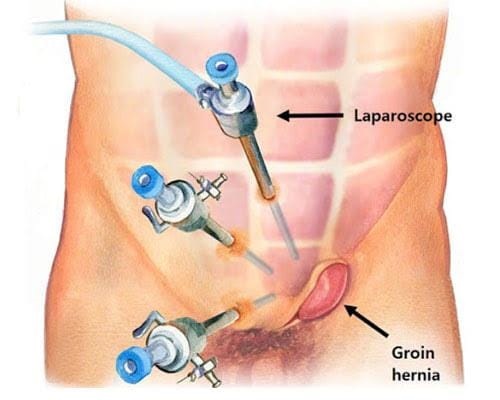Laparoscopic Hernia Repair
What Is
Laparoscopic Hernia Repair?
Inguinal hernia can be repaired either by the traditional “open” approach (which is associated with more pain and an average recovery time of as long as 6 weeks) or by using a small telescope known as a laparoscope (with less pain and much smaller scars).
Laparoscopic hernia repair is a surgical intervention to repair a weakness in the abdominal wall (muscle) by using a thin, lighted telescope and a mesh to patch the defect. This ensures less discomfort post-surgery, minimal scarring, as well as a faster return to the patient’s regular activity.

Benefits of Laparoscopic Hernia Repair
Minimizes postoperative pain
Reduces the requirement for painkillers
Can repair both sides via the same laparoscopic port sites for bilateral hernias
Earlier return to daily activities and work
Can be performed for recurrent inguinal hernia
Downside of Laparoscopic Repair
Higher cost due to instrument/laparoscopic costs
Which Patients Should Undergo Laparoscopic Hernia Repair?
This decision is usually made by a surgeon by performing a thorough examination. The laparoscopic procedure may not be suitable for patients who have previously undergone abdominal surgery, prostate surgery, or have certain underlying medical conditions.
What Prior Preparations Are Required?
- Usually, laparoscopic hernia operations are performed as a day surgery procedure or an overnight stay in hospital
- The surgeon will perform preoperative tests, such as blood test, medical evaluation, and an electrocardiogram (ECG).
- The surgeon will also take a written consent from the patient before performing the surgery, which states the risks and positive aspects of the surgery.
- A patient should not consume any food or drink on the night before the surgery, except for medicines recommended by the surgeon.
- Drugs, such as aspirin, anticoagulants, and anti-inflammatory medications (arthritis medications) should be avoided.
- Your doctor may further advise to quit smoking to minimize recurrence.
How Is The Laparoscopic Surgery Performed?
- Laparoscopic surgery is performed with the use of a tiny telescope connected to a special camera, which is inserted through a cannula to permit the surgeon to visualize the hernia.
- The surgeon uses a surgical mesh to place over the hernia defect, and the mesh is fixed to the surrounding tissue using staples, adhesive sealant, or sutures.
- Modern and newer meshes are made of flexible materials that stay in the abdomen and encourage new tissues to grow into them.
Under What Circumstances Laparoscopic Surgery Cannot Be Performed?
It is at the surgeon discretion or judgement to convert the laparoscopic surgery to an open procedure.
Factors that may increase the possibility to convert to open method are:
- Obesity
- Bleeding problems
- Prior abdominal surgery causing scar tissue
- Inability to visualize organs
What Are the Potential Complications after the Surgery?
The main potential complications after the operation are:
- Difficulty with urination after surgery
- Bruising and swelling of the scrotum, the base of the penis, and the testicles
- Bleeding
- Infection
- Injury to the nearby organ such as urinary bladder, intestines, blood vessels, nerves, spermatic cord (in males)
